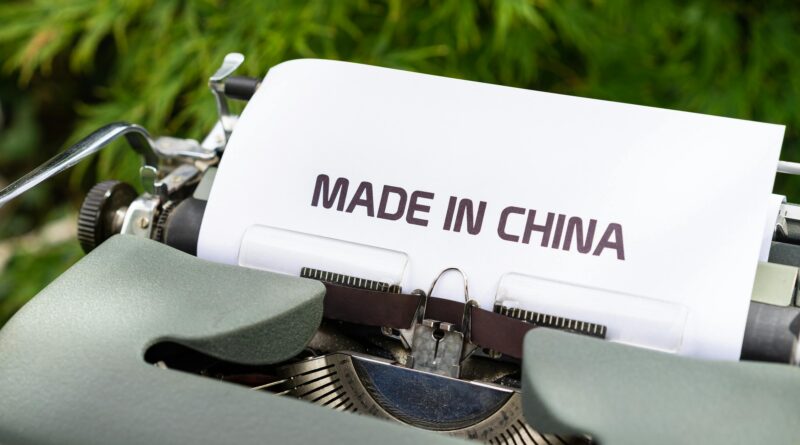Breaking Away from Dependence on China Made Goods
Breaking Away from Dependence on China Made Goods
Table of Contents
1. Introduction
Breaking Away from Dependence on China Made Goods
Breaking Away from Dependence on China Made Goods. The global economy is intricately linked, and China’s role as a manufacturing powerhouse is undeniable. However, recent geopolitical tensions, trade disputes, and the COVID-19 pandemic have highlighted the risks of over-reliance on a single country for essential goods. This post explores strategies for reducing dependence on China-made goods, ensuring economic resilience and stability.
The most important point to remember is to never support a country that has ambitions to destroy your country or the country of your allies. Always give business to American companies or other friendly nations. Help defend Freedom before it’s too late. President Trump knew and understood the threat of dependence on China made goods. Then the Illegitimate president Biden undid all of the things President Trump did to end the practice. American consumers and consumers around the world can do more than the Governments can though. The consumer decides whether or not to give their money to fund a communist regime bent on world domination.
2. Understanding the Dependency
China has become the world’s factory, producing a significant portion of consumer electronics, textiles, machinery, and other goods. This dependency arises from several factors:
- Cost Efficiency: China’s low labor costs and economies of scale make it an attractive manufacturing hub.
- Infrastructure: Advanced logistics and supply chain infrastructure facilitate mass production and distribution.
- Specialization: Many Chinese regions have specialized in specific industries, creating expertise and efficiencies.
However, this dependency poses risks, including supply chain disruptions, geopolitical vulnerabilities, and economic imbalances.
3. Economic and Political Implications
Dependence on China for manufactured goods has several implications:
- Economic Risks: Disruptions in Chinese production can lead to shortages and increased costs.
- Political Leverage: Over-reliance gives China significant geopolitical leverage.
- Trade Deficits: High import volumes from China contribute to trade deficits for many countries.
Balancing trade and production is crucial for mitigating these risks.
4. Steps to Reduce Dependence
4.1 Diversifying Supply Chains
Diversification involves sourcing goods from multiple countries to spread risk. Steps include:
- Identifying Alternative Suppliers: Research and establish relationships with manufacturers in other countries.
- Regional Partnerships: Collaborate with neighboring countries to build regional supply chains.
- Risk Assessment: Regularly assess and mitigate risks associated with different suppliers.
4.2 Encouraging Domestic Manufacturing
Strengthening domestic manufacturing capabilities can reduce dependence. Key actions include:
- Investment in Technology: Adopt advanced manufacturing technologies to increase efficiency.
- Skilled Workforce Development: Invest in education and training to build a skilled workforce.
- Incentives for Local Production: Provide tax breaks, grants, and subsidies to encourage domestic production.
4.3 Promoting Trade with Other Countries
Diversifying trade partners can help mitigate risks. Steps include:
- Bilateral and Multilateral Agreements: Engage in trade agreements to facilitate imports and exports.
- Trade Missions: Conduct trade missions to explore opportunities in emerging markets.
- Market Research: Invest in market research to understand demand and establish trade relations.
4.4 Supporting Small and Medium Enterprises (SMEs)
SMEs play a crucial role in diversifying the economy. Support measures include:
- Access to Finance: Provide loans and grants to support SME growth.
- Innovation Hubs: Establish hubs to foster innovation and collaboration among SMEs.
- Export Support: Offer assistance for SMEs to explore export opportunities.
4.5 Consumer Awareness and Education
Consumer behavior can drive demand for locally-made goods. Key strategies include:
- Educational Campaigns: Inform consumers about the benefits of buying local.
- Labeling Initiatives: Clearly label products to indicate their country of origin.
- Promotional Programs: Run campaigns to promote locally-made products.
5. Government Policies and Initiatives
Governments play a crucial role in reducing dependence on China-made goods through:
- Regulatory Support: Implement policies that support local industries and reduce bureaucratic hurdles.
- Trade Policies: Adjust tariffs and quotas to encourage imports from diverse sources.
- Infrastructure Development: Invest in infrastructure to support local manufacturing and distribution.
6. Challenges and Considerations
Reducing dependence on China-made goods presents several challenges:
- Cost Implications: Transitioning supply chains can be expensive.
- Time-Consuming: Building new manufacturing capabilities takes time.
- Quality and Consistency: Ensuring quality and consistency from new suppliers can be challenging.
Balancing these challenges with the benefits of reduced dependency is crucial.
7. Conclusion
Breaking away from dependence on China-made goods is a multifaceted approach that requires collaboration between governments, businesses, and consumers. By diversifying supply chains, encouraging domestic manufacturing, promoting trade with other countries, supporting SMEs, and educating consumers, nations can build more resilient and balanced economies. While the transition may be challenging, the long-term benefits of economic stability and reduced geopolitical risks make it a worthwhile endeavor.
Detailed Steps to Reduce Dependence
Step-by-Step Approach
Step 1: Diversifying Supply Chains
- Research and Identify Alternative Suppliers: Investigate potential suppliers in different countries. Consider factors such as cost, reliability, and political stability.
- Develop Regional Partnerships: Establish partnerships with manufacturers in neighboring countries to create regional supply chains.
- Conduct Risk Assessments: Regularly evaluate the risks associated with different suppliers and develop contingency plans.
Step 2: Encouraging Domestic Manufacturing
- Invest in Advanced Manufacturing Technologies: Adopt technologies such as automation, AI, and IoT to improve efficiency and reduce costs.
- Enhance Workforce Skills: Invest in education and vocational training to develop a skilled workforce capable of supporting advanced manufacturing.
- Provide Financial Incentives: Offer tax breaks, grants, and subsidies to businesses that invest in local manufacturing.
Step 3: Promoting Trade with Other Countries
- Negotiate Trade Agreements: Engage in bilateral and multilateral trade agreements to facilitate the flow of goods and services.
- Organize Trade Missions: Conduct trade missions to explore new markets and establish trade relationships.
- Invest in Market Research: Understand the demand and regulatory landscape in target markets to optimize trade strategies.
Step 4: Supporting SMEs
- Facilitate Access to Finance: Provide SMEs with access to loans, grants, and other financial instruments.
- Establish Innovation Hubs: Create hubs that support collaboration, innovation, and knowledge sharing among SMEs.
- Assist with Export Opportunities: Provide resources and support for SMEs to enter and compete in international markets.
Step 5: Consumer Awareness and Education
- Launch Educational Campaigns: Educate consumers about the benefits of buying locally-made products through various media channels.
- Implement Labeling Initiatives: Ensure products are clearly labeled with their country of origin to help consumers make informed choices.
- Promote Local Products: Run promotional campaigns highlighting the quality and benefits of locally-made products.
Government Policies and Initiatives
- Regulatory Support: Simplify regulations and reduce bureaucratic hurdles for businesses.
- Trade Policies: Adjust tariffs and quotas to favor imports from diverse sources and support local industries.
- Infrastructure Development: Invest in transport, logistics, and digital infrastructure to support efficient manufacturing and distribution.
Conclusion
Breaking Away from Dependence on China Made Goods
By following these detailed steps, countries can progressively reduce their dependence on China-made goods. This strategic shift will enhance economic resilience, create job opportunities, and foster innovation within domestic industries. While the journey requires effort and investment, the long-term benefits of a diversified and balanced economy are substantial and far-reaching.
Always work at educating yourself and others about the dangers of supporting china with your money. Learn about products NOT made in china and spread the word. For example here’s just a sample of sources to locate Not Made In China goods.
- China Never: Products Not Made In China
- Best Products not made in China – No to China 2024
- Not Made in China Directory – Best Place to Buy Non-Chinese Products
- 1,580+ companies whose products are not made in China




